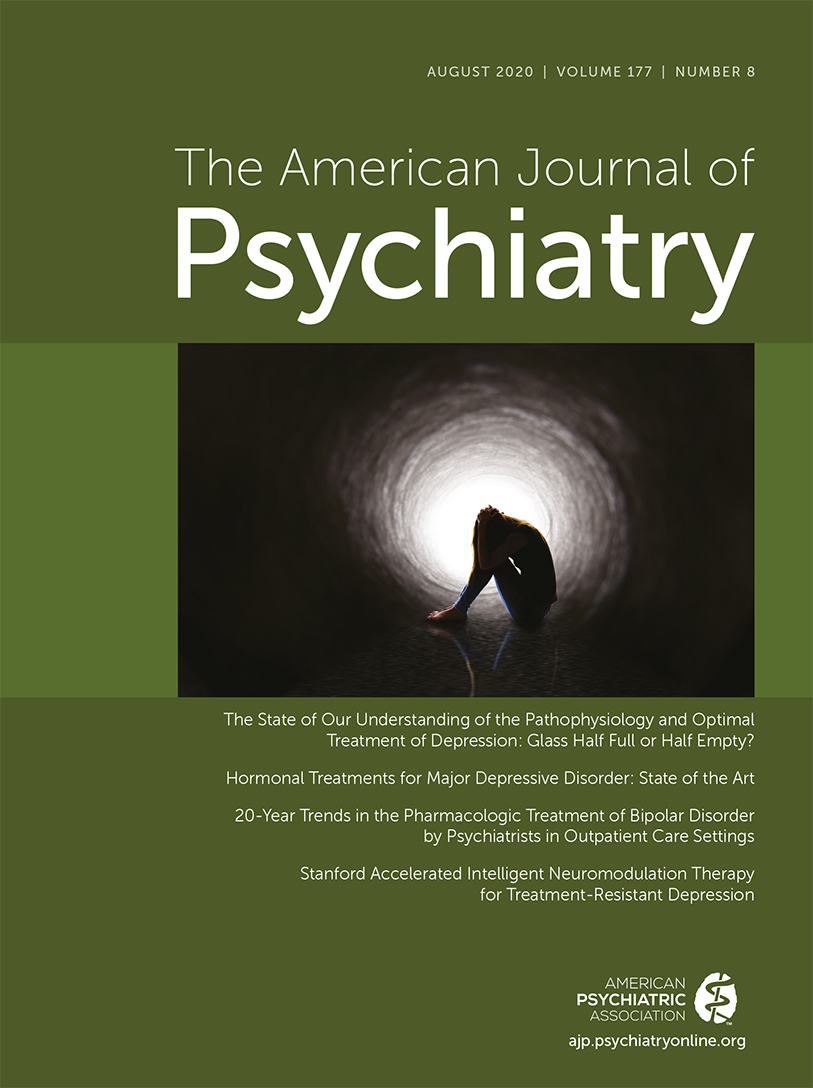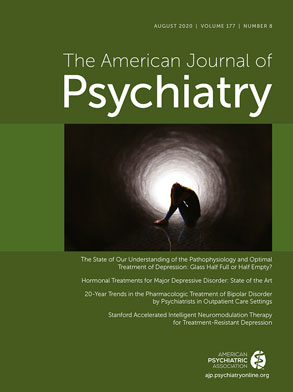Depression is a serious public health problem: this prevalent, debilitating disorder is experienced by 264 million people worldwide, is a top cause of disability, and can lead to suicide (
1). What many rarely consider is that depression is a developmental disorder, with adolescence as a vulnerability period (
2). Depression can occur as early as the preschool years, however, and our field has now proceeded from establishing that it exists in young people (
3) to observing that it can begin in early childhood (
4) to, more recently, identifying some of its key mechanisms.
A burgeoning clinical and affective neuroscience literature has revealed that disrupted neural reward circuitry is a correlate (
5,
6), a predictor (
7), and, very likely, a causal factor (
8) in depression. More than 10 years after our initial report that adolescents with depression have altered striatal and medial prefrontal function (
9), we have details on the associated pattern of function in frontostriatal reward circuitry, which seems more pronounced in adolescents than adults and is more evident during the anticipation than the receipt of reward (
6). Still, we know little about the possible unfolding of neural alterations over the course of depression. Not to be neglected, there is also a need to understand the role of frontostriatal function in depression in a developmental context.
To date, the holy grail among those who study the developmental neuroscience of depression has been to conduct large, prospective, longitudinal neuroimaging studies so that we can separate causes from correlates from consequences. We don’t know, for example, whether low ventral striatal response accompanies every period of high severity of depression or instead, as observed in young people at risk for depression (
10), it simply reflects a stable tendency toward the disorder. Depression-frontostriatal associations could wax and wane over the course of the disorder. Moreover, different aspects of frontostriatal function could maintain depression, lead to recurrence, create vulnerability to other forms of psychopathology, or reflect scarring effects. Because normative change in frontostriatal circuitry continues at least through late adolescence (
11), an extra challenge for a developmentally informed approach is to investigate the unfolding of depression against the backdrop of an evolving neural circuitry. Specifically, how is the typical trajectory of frontostriatal function altered in those who experience depression?
The report by Rappaport et al. (
12) in this issue of the
Journal takes an initial step by addressing a compelling and important gap: differences between current and cumulative depression in their association with adolescents’ frontostriatal function. This work builds on an impressive and unique longitudinal study that enrolled 306 children ages 3–6 with elevated depressive symptoms and followed them annually through their late teens. Cumulative and current depression were associated with different patterns of frontostriatal response during adolescence. In addition, the developmental point at which depression was experienced appeared to influence the regions exhibiting disruption: while depression during early childhood was related to low responding in the dorsal striatum, ventral striatum, and rostral anterior cingulate cortex, depression during adolescence (but not earlier) was related to low responding in the nucleus accumbens.
These results fit the story of reward circuitry nicely and highlight some needed developmental neuroscience research. A large literature on systems neuroscience reveals the accumbens as a hub of reward circuitry that is tied to experience and expectation of reward (
13). In depression, the accumbens could be disrupted in concert with current affective and motivational state but be impervious to previous experience or chronicity. As development of the accumbens is related to adolescent-limited risk-taking behavior (
14), it could be particularly sensitive to mood changes during this developmental period. Whether it would also be less responsive in early childhood depression is a relevant question. The reward regions related to cumulative and childhood depression have putative functions involving habit, salience, and reward-driven behavior. These regions could adapt in a compensatory way, as the authors consider when they thoughtfully draw an analogy between their findings and Everitt’s model of addiction (
15), in which functional alterations shift from the accumbens to the orbitofrontal cortex with the progression of illness. For depression, repeated assessment across time and development could help determine whether frontostriatal adaptation occurs, is discontinuous across developmental periods, or relates to outcomes such as increasing severity or treatment resistance.
For next steps after this pioneering study, we should aim for greater depth of developmental examination of frontostriatal mechanisms of depression. All participants in the Rappaport et al. study were adolescents at the time of neuroimaging, which leaves questions about frontostriatal function in children with depression and predepression alterations in frontostriatal functioning. Also, computing functional connectivity is an approach that would build on the study’s operationalization of frontostriatal circuitry as mean blood-oxygen-level-dependent response in a set of six regions that includes most of the usual reward suspects (but not all: the dorsal caudate, orbitofrontal cortex, and medial prefrontal cortex were not selected). Interestingly, the medial prefrontal cortex emerged from whole-brain analyses with current depression, suggesting that it is a central component worth including in studies of frontostriatal disruption in depression (although potentially weighted negatively when added to models, to reflect findings of its heightened responsiveness in depression [
5]). Expanding the developmental focus, one question the study cannot answer is how adults with depression—whether new or with onset in adolescence or childhood—compare with adolescents. Finally, taking an individual-differences approach to frontostriatal change with clinical course would answer pressing questions about within-person pathways toward illness or resilience.
Three larger hypotheses follow from the findings in the Rappaport et al. study. One intriguing possibility is that depression and frontostriatal function fluctuate together over time, especially for the coupling of depression severity and accumbens function. Another is that the two processes have bidirectional influence. Frontostriatal function could influence depression, serving as a predisposing factor for reactivity to stressors or a mediating factor that links life experiences to depression. Maybe less intuitively, the flow of influence could occur from the disruptions accompanying depression—from low motivation to impaired social functioning (
16) to frontostriatal function, as the experience of adversity appears to influence frontostriatal function (
17). A third possibility is that this research has immediate clinical utility. We know that it is inaccurate to say that depression is depression is depression. Among individuals with depression, it appears that a more typical frontostriatal response to reward distinguishes those who benefit from the usual treatments (
18). Those fortunate people could be the ones who avoid experiencing anhedonia, a symptom associated with disrupted frontostriatal function and poor treatment response. Consistent with the widely documented heterogeneity in phenotype and treatment response in depression (
19), frontostriatal variability over time could create a foundation for matching people to treatments or developing new treatments.
What would the current version of the holy-grail study on frontostriatal circuitry and depression look like? As always, it would be prospective and longitudinal. It would follow a large sample from a vulnerable population from childhood through adulthood. It would include frequent measurement of brain function, with assessments before, during, and after depression’s onset. It would focus on developmental factors and co-occurring problems, with an eye toward varying pathways, outcomes, and phenotypes. It would incorporate treatment experiences and outcomes to understand the mechanisms and consequences of change. In the end, it would provide answers about pathophysiology and course. More importantly, it would move us toward preventing and alleviating suffering.

